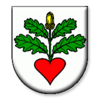Rakúsy
| Rakúsy | ||
|---|---|---|
| coat of arms | map | |

|
|
|
| Basic data | ||
| State : | Slovakia | |
| Kraj : | Prešovský kraj | |
| Okres : | Kežmarok | |
| Region : | Spiš | |
| Area : | 6.341 km² | |
| Residents : | 3,356 (Dec. 31, 2019) | |
| Population density : | 529 inhabitants per km² | |
| Height : | 704 m nm | |
| Postal code : | 059 76 ( Mlynčeky Post Office ) | |
| Telephone code : | 0 52 | |
| Geographic location : | 49 ° 11 ' N , 20 ° 23' E | |
| License plate : | KK | |
| Kód obce : | 523798 | |
| structure | ||
| Community type : | local community | |
| Administration (as of November 2018) | ||
| Mayor : | Lenka Fedáková | |
| Address: | Obecný úrad Rakúsy 35 059 76 Rakúsy |
|
| Website: | www.rakusy.sk | |
| Statistics information on statistics.sk | ||
Rakúsy (until 1927 Slovak "Rokus"; German Roks or Rox , Hungarian Rókus - until 1907 Rokusz ) is a place and a municipality in Okres Kežmarok of the Prešovský kraj , with 2819 inhabitants.
geography
The municipality is located at the foot of the Bela Tatras , a part of the Tatra Mountains , at the eastern end of the Podtatranská kotlina basin . The Krivodol stream flows through the main town and its tributary Čierna voda to the north . The former flows into the Poprad at Spišská Belá . Rakúsy is six kilometers from Kežmarok .
Although the municipality is not officially divided into parts, there is a Roma settlement 2 km northwest of the main town (Slovak rómska osada ).
history
The place was founded in the 13th century and is first mentioned in 1288 as Rokus . The original inhabitants were German colonists who immigrated to the Hungarian Zips county . Until serfdom was abolished in the 19th century, the place was divided between various Junkers and the city of Käsmark. The population was engaged in agriculture. In the 19th century there was an immigration of Slovak families and Roks became a German-Slovak community.
The place, which was in the Kingdom of Hungary until 1918, then became part of Czechoslovakia. At the end of the Second World War, the Germans had to leave the community and the place was settled with the families and relatives of the Roma, who had to vacate the Javorina military area. Today, it is estimated that the Roma make up around three quarters of the community's population.
Attractions
There is a Roman Catholic and Protestant church and a classicist curia from the 19th century in the village.
